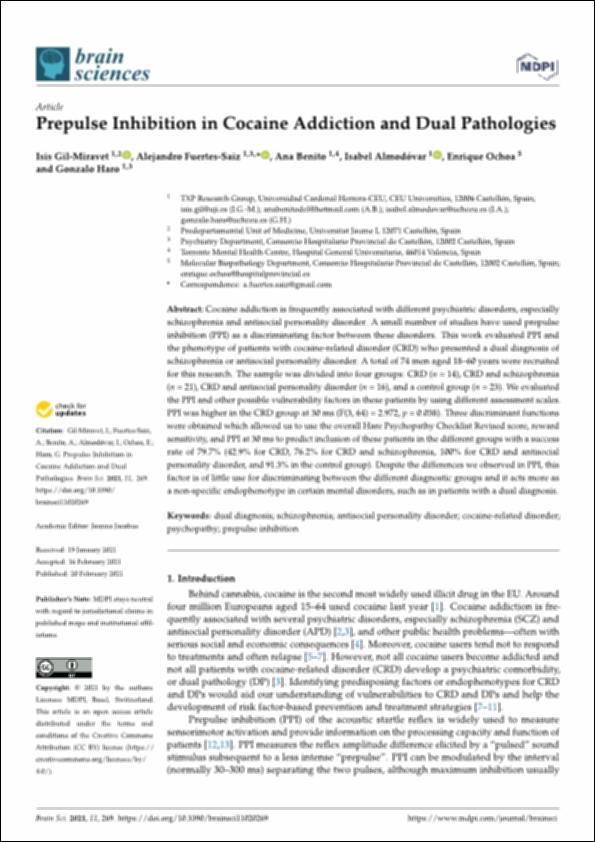Por favor, use este identificador para citar o enlazar este ítem:
http://hdl.handle.net/10637/13607Prepulse inhibition in cocaine addiction and dual pathologies
| Título : | Prepulse inhibition in cocaine addiction and dual pathologies |
| Autor : | Gil Miravet, Isis Fuertes Saiz, Alejandro Benito Delegido, Ana Almodóvar Fernández, Isabel Ochoa de Aranda, Enrique Haro Cortés, Gonzalo Rafael |
| Materias: | Psicopatología.; Psychology, Pathological.; Cocaína - Adicción.; Cocaine abuse.; Trastorno de personalidad antisocial - Diagnóstico.; Schizophrenia - Diagnosis.; Personality disorders - Diagnosis.; Antisocial personality disorder - Diagnosis.; Personalidad - Trastornos - Diagnóstico.; Esquizofrenia - Diagnóstico. |
| Editorial : | MDPI |
| Citación : | Gil-Miravet, I., Fuertes-Saiz, A., Benito, A., Almodóvar, I., Ochoa, E. & Haro, G. (2021). Prepulse inhibition in cocaine addiction and dual pathologies. Brain Sciences, vol. 11, i. 2 (20 feb.), art. 269. DOI: https://doi.org/10.3390/brainsci11020269 |
| Resumen : | Cocaine addiction is frequently associated with different psychiatric disorders, especially schizophrenia and antisocial personality disorder. A small number of studies have used prepulse inhibition (PPI) as a discriminating factor between these disorders. This work evaluated PPI and the phenotype of patients with cocaine-related disorder (CRD) who presented a dual diagnosis of schizophrenia or antisocial personality disorder. A total of 74 men aged 18–60 years were recruited for this research. The sample was divided into four groups: CRD (n = 14), CRD and schizophrenia (n = 21), CRD and antisocial personality disorder (n = 16), and a control group (n = 23). We evaluated the PPI and other possible vulnerability factors in these patients by using different assessment scales. PPI was higher in the CRD group at 30 ms (F(3, 64) = 2.972, p = 0.038). Three discriminant functions were obtained which allowed us to use the overall Hare Psychopathy Checklist Revised score, reward sensitivity, and PPI at 30 ms to predict inclusion of these patients in the different groups with a success rate of 79.7% (42.9% for CRD, 76.2% for CRD and schizophrenia, 100% for CRD and antisocial personality disorder, and 91.3% in the control group). Despite the differences we observed in PPI, this factor is of little use for discriminating between the different diagnostic groups and it acts more as a non-specific endophenotype in certain mental disorders, such as in patients with a dual diagnosis. |
| Descripción : | Este artículo se encuentra disponible en la siguiente URL: https://www.mdpi.com/2076-3425/11/2/269 Este artículo de investigación pertenece a la sección "Systems Neuroscience". |
| URI : | http://hdl.handle.net/10637/13607 |
| Derechos: | http://creativecommons.org/licenses/by/4.0/deed.es |
| ISSN : | 2076-3425 (Electrónico) |
| Fecha de publicación : | 20-feb-2021 |
| Centro : | Universidad Cardenal Herrera-CEU |
| Aparece en las colecciones: | Dpto. Medicina y Cirugía |
Los ítems de DSpace están protegidos por copyright, con todos los derechos reservados, a menos que se indique lo contrario.


